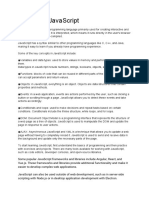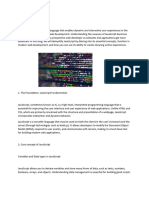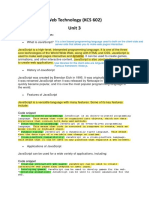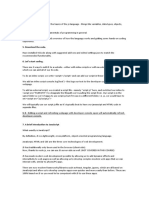0% found this document useful (0 votes)
5 views4 pagesJs Notes
JavaScript is a lightweight, interpreted programming language used for both client-side and server-side development, standardized under ECMAScript specifications. Key features include dynamic typing, first-class functions, and event-driven programming, making it essential for modern web development. Mastering its fundamentals is crucial for advancing to frameworks and full-stack development.
Uploaded by
evansCopyright
© © All Rights Reserved
We take content rights seriously. If you suspect this is your content, claim it here.
Available Formats
Download as PDF, TXT or read online on Scribd
0% found this document useful (0 votes)
5 views4 pagesJs Notes
JavaScript is a lightweight, interpreted programming language used for both client-side and server-side development, standardized under ECMAScript specifications. Key features include dynamic typing, first-class functions, and event-driven programming, making it essential for modern web development. Mastering its fundamentals is crucial for advancing to frameworks and full-stack development.
Uploaded by
evansCopyright
© © All Rights Reserved
We take content rights seriously. If you suspect this is your content, claim it here.
Available Formats
Download as PDF, TXT or read online on Scribd
/ 4
































































